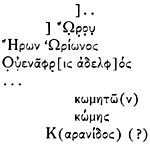
|
|||
|
|
|||
|
 for for  is not common in papyri and ostraca
generally50 and is used in the Karanis
ostraca only in chaff receipts51 in the
expression is not common in papyri and ostraca
generally50 and is used in the Karanis
ostraca only in chaff receipts51 in the
expression  .52 This singularity points to No. 587
as being a chaff receipt. Furthermore, a close scrutiny of the writing
with relation to the upper and lower edges of the ostracon reveals
that lines 5-8 in Amundsen's transcript are not in reality four lines
but the four halves of two lines. The last line is faded along with
the rest, and the unevenness of the lower edge has produced a
distortion in the appearance of the visible remnants. Normally the
size and shape of an ostracon have little importance for the
interpretation of the text which it bears, apart from the conciseness
imposed by a severely limited space, but No. 587 is one of the few for
which it is profitable to study the physical characteristics of the
ostracon.53 .52 This singularity points to No. 587
as being a chaff receipt. Furthermore, a close scrutiny of the writing
with relation to the upper and lower edges of the ostracon reveals
that lines 5-8 in Amundsen's transcript are not in reality four lines
but the four halves of two lines. The last line is faded along with
the rest, and the unevenness of the lower edge has produced a
distortion in the appearance of the visible remnants. Normally the
size and shape of an ostracon have little importance for the
interpretation of the text which it bears, apart from the conciseness
imposed by a severely limited space, but No. 587 is one of the few for
which it is profitable to study the physical characteristics of the
ostracon.53
From these points of view, obtained by a critical examination of the ostracon, a new text has emerged. It is found to be a typical chaff receipt. The ostracon is broken below line 5 and approximately three lines of text are lost at the bottom.

|
|||
|
|||
|
|
|||
|
Created by the Digital
Documentation Center at AUB
in collaboration with Al
Mashriq of Høgskolen i
Østfold, Norway. 990211 PN - Email: hseeden@aub.edu.lb |

 51. For bibliography pertinent to chaff receipts see TAPA, LXXII, 194 1, pp. 448 f., esp. nn. 44, 45.
51. For bibliography pertinent to chaff receipts see TAPA, LXXII, 194 1, pp. 448 f., esp. nn. 44, 45.

 or
or  is required by the
context. Cf. O. Mich., I, 18 6, 2-3 ; 214, 2; 215, 2; 217, 1-2;
219, 2; 233, 3. There is space for a short word either at the end of
line 3 or at the beginning of line 4, and such writing as may stand in
either place is equally hard to detect. In reading
is required by the
context. Cf. O. Mich., I, 18 6, 2-3 ; 214, 2; 215, 2; 217, 1-2;
219, 2; 233, 3. There is space for a short word either at the end of
line 3 or at the beginning of line 4, and such writing as may stand in
either place is equally hard to detect. In reading